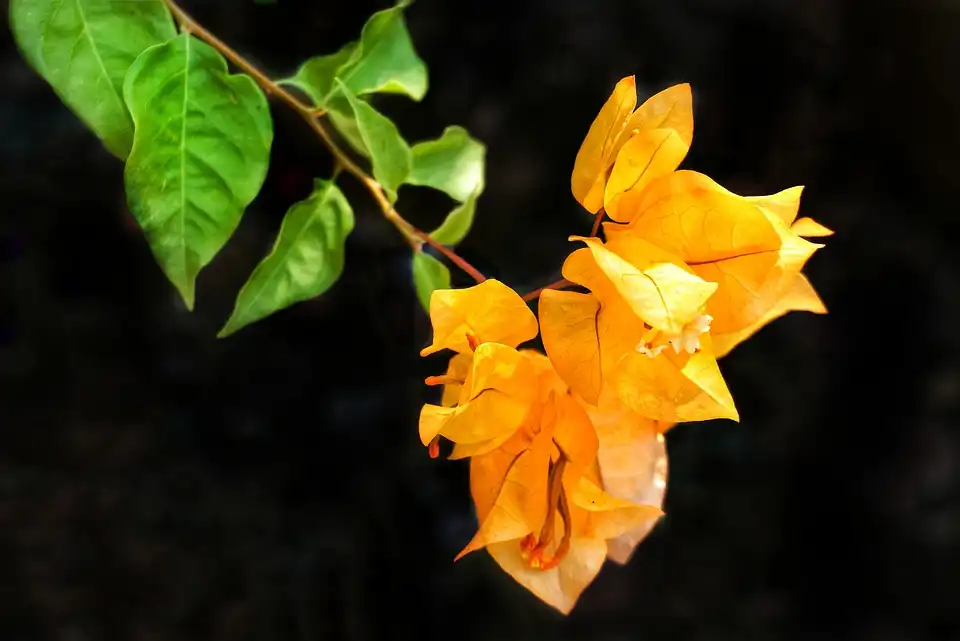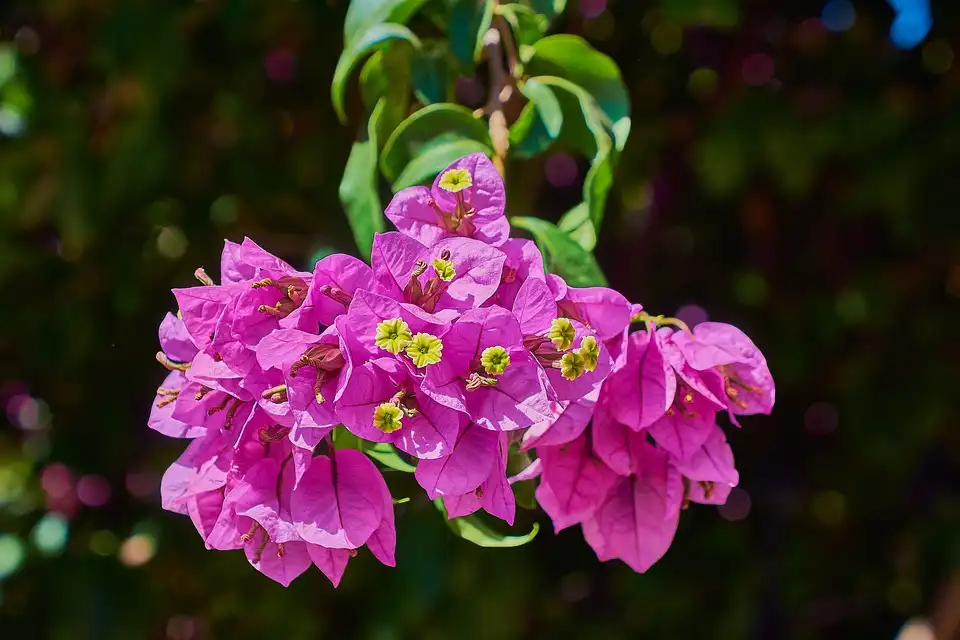When do Bougainvilleas Bloom?
While this genus has stunning specimens for bonsai trees, one question that often appears is when do Bougainvilleas bloom. While there’s a quick answer for this query, we want to take a detailed look as to why it may not be happening and how you can encourage more bracts and flowers. There may be a reason you don’t see anything happening as yet.
We’ll make sure to help you as much as possible determine when your Bougainvillea is meant to bloom.
When do Bougainvilleas Bloom?
To understand when Bougainvilleas bloom, we need to explain that your region will have an impact on your bonsai’s bracts and flowers. For the most part, it’s an evergreen tree in warmer climates, where you won’t see the leaves change color or drop. There’s also a chance you may see it bloom more than once in the year: spring and autumn.
However, colder climates turn these beautiful bonsai trees into semi-deciduous specimens, where you’ll notice the leaves fall and the bracts wilt and die. In these situations, you’ll more likely only see one bloom in late spring or early summer. It may even extend into the middle of summer if your spring is colder than expected.
The best regions to grow Bougainvilleas for optimal blooms are hardiness zones 9 – 11. You may see blooms for several months outside the anticipated seasons if you provide excellent conditions for it to thrive. Keep it outdoors where it can soak the sun in the early morning until mid-afternoon.
What Time Of Year Does Bougainvillea Bloom?
The time of year when your Bougainvillea will bloom depends on where you live. If you’re in the northern hemisphere, you can expect to see the flowers appear between May to July in colder climates. If you’re in the right zone with warm temperatures all year round, there should be another burst of bracts and flowers around December. When it’s too cold, then December is when the foliage will start falling off.
In the southern hemisphere, your first Bougainvillea blooms should appear between November and January, maybe even into February. If you live in a tropical region with warmer temperatures, you should expect more flowers in May. You’ll need to ensure there’s sufficient sunlight even in the colder months so that it has enough energy to support the new growth.
Does Bougainvillea Bloom All Year Round?
If you live in hardiness zones 9 – 11, you’ll see Bougainvillea blooms appear on and off throughout the year. It enjoys the heat and sunshine, and there’s always a chance for pollination and propagation. Should you be in areas outside these zones where you have cold winters, you’ll only have one period of flowering, while the bracts and leaves will fall off so the bonsai tree can rest.
We encourage you to let it sleep during this period. It needs as much rest as it can to prepare for the upcoming spring. If you see it wants to go dormant, don’t try and force it to stay awake with fertilizer and over-exposure to sunlight. It’s letting you know that it wants to rest, so let it.
Why Is My Bougainvillea Not Flowering?
A primary concern for bonsai lovers is when their Bougainvilleas don’t bloom in the right season. You wait for months throughout spring and summer, and nothing is happening. Should this be your situation, we recommend you look at the following aspects to see where the problem is.
Overwatering
One element that Bougainvillea bonsais love is living in drought-like conditions. You can get away with giving it a lengthy bath once a week while steering clear from daily watering. It’s a common mistake to feel that you should water daily when the summer heat arrives.
If you’re watering your Bougainvillea too regularly, you won’t see any blooms appearing. The tree is stressing, and you may be causing diseases to form on the roots. Let the soil dry out completely before you give it another wash. There should be at least three to four days of no watering, even in summer.
Overfeeding
You might think that giving your bonsai more food will help when the Bougainvilleas do bloom. However, the nitrogen levels will boost green foliage development at the sacrifice of your bracts and flowers. When you notice more leaves forming instead of blooms, it’s time to cut back on the fertilizing.
Another option is changing the ratio with a different fertilizer. Instead of a balanced approach (10:10:10), you can aim for a solution with less nitrogen (5:15:15). In this way, the potassium and phosphorous will encourage your Bougainvillea to bloom in spring and summer while the foliage will slow down.
Insufficient Sunlight
The areas where Bougainvilleas bloom the most as in South American countries. They’re treated to direct sunlight, which is the condition you need to replicate. It needs at least six hours of direct light to produce a dense mass of flowers and bracts. If you’re growing it indoors or there’s only indirect light, don’t expect the flowers to bloom.
We understand that you might be living outside the recommended hardiness zone, where it’s cold and you’re caring for the bonsai tree inside. Still, you should place it by the window where it can soak as much natural sunlight as possible. It doesn’t do too well with a grow light.
Long Days
This statement may seem like it contradicts the previous section, but to make your Bougainvillea bloom, you need to have less than 12 hours of daylight. In the South American regions where they grow best, they have short days and long nights. So, while it needs intense sunlight, you should only restrict it to a few hours in the day.
You can place it in your garden against a wall that provides shade in the afternoon. Another option is moving a shade cloth over it at a specific time to ensure that it does it doesn’t take in any more light.
Slow Draining
We already mentioned that overwatering is a bad idea when you want Bougainvilleas to bloom. Connected to this aspect is slow drainage. While you may not water as much, the liquid remains trapped in the soil, making it turn rotten and infect the roots with fungal diseases. In the end, it can’t absorb the nutrients it needs for the flowers and bracts.
We recommend placing drainage rocks at the bottom of the pot and use soil that’s known to drain water relatively quickly. There only needs to be enough moisture for the Bougainvillea bonsai to drink over a few days. We also encourage you not to use any water trays.
Cold Temperatures
When temperatures drop too low in the evening, don’t expect your Bougainvillea to bloom. The ideal range is about 65°F at night, which will encourage it to flower over the warm season. It can handle slightly lower temperatures, but not for weeks on end.
Another aspect to consider is if the season is strangely colder than expected. If spring has arrived and the first few months are not as warm as you’re used to, that could be why your Bougainvillea isn’t flowering. You can bring it inside, but you need to place it by a window for sunlight during the day.
Alkaline Conditions
Finally, let’s discuss the soil’s pH level. We mentioned that Bougainvilleas need potassium and phosphorous to bloom and nitrogen for the leaves. However, alkaline soil prevents the bonsai tree from absorbing nutrients, which is why you may not be seeing flowers or foliage.
If possible, test the soil’s pH level to see if it’s below 6.0. Ideally, you should have it between 5.5 and 6.0. If it’s too high on the alkaline side, you should make it more acidic. You can use a liquid solution or organic mulch, such as pine needles.
How Do You Prune A Bougainvillea For Maximum Bloom?
When Bougainvilleas are ready to bloom, there’s a way you can ensure you have maximum flowering throughout the growing season. It entails pruning your bonsai at the right time the right way. Here are the steps you should follow:
- Start in Early Spring: You’ll want to start this process after the frost and cold are gone and the first buds start appearing. You don’t want to wait too long and interrupt the development stages.
- Wear Protection: Most Bougainvillea species have large thorns that can penetrate your skin and cause rashes to appear due to mild toxins. To prevent any problems from occurring, we recommend using thick gloves and clothes so that they don’t cut you open.
- Sanitize the Equipment: Pruning these bonsais means you need to disinfect your tools a few times. Firstly, you’ll need to cleaning them before you start cutting, as you don’t want diseases from other trees spreading onto your Bougainvillea. Then, you need to clean it after so that the sap doesn’t cause issues with other species.
- Remove Dead Parts of the Tree: When you start pruning, cut away any branches, leaves, or stems that look dead. They will sap the nutrients, and you’ll see less foliage and flowers develop. You should also see if any parts look dehydrated, which means they aren’t getting enough water to that part of the bonsai.
- Remove Massive, Unsightly branches: If you want a dense mass of flowers to appear, you should cut away any large branches on your bonsai. You don’t need to prune all the way back to the trunk. The idea is to encourage more branches to form over spring so more blooms can appear when summer arrives.
- Trim as it Grows: As the new shoots develop, you’ll trim them back a few nodes to encourage more shoots to form. You’ll do this throughout the growing months, reducing leaf size but increasing the numbers to make it bushier in appearance.
- Pinch Dying Blooms: When you see the flowers are done blooming on your Bougainvillea bonsai, you can pinch them just above the branch underneath it. Use your fingers to pinch off the soft growth instead of tools. You’ll see new bracts and flowers appear.
- Cut Back in Growing Season: Another way you can encourage new flowers is to cut halfway down the stems in the middle of the season, removing all current blooms. You’ll see new branches and leaves show first before the second batch of flowers arrive.
What Kind Of Fertilizer Makes Flowers Bloom?
There are many fertilizers out there that highlight that they work well with flowering trees, such as when Bougainvilleas bloom. You’ll see stunning photos on the cover of the bottles, attracting your attention to the fact that they assist with flowering. But what nutrient is responsible for this task?
While nitrogen is essential for green foliage, phosphorous is the one that aids with root development and flower growth. Potassium assists with cell formation and branches, but phosphorous is the one you want to focus on. We usually recommend a lower nitrogen level with balanced phosphorous and potassium for healthy Bougainvillea blooms.
Final Thoughts
While Bougainvilleas mainly bloom during spring and summer, there are conditions where you’ll see flowers on and off throughout the year. Of course, you’ll need to ensure that it has the right nutrients, light levels, and water, but it’s all in a day’s work. We hope this guide has helped you in cultivating stunning flowers on your bonsai tree.







